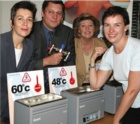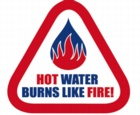Preventing the risk of scalding

Scalding accidents are wholly avoidable — Nic Mallinson.
Nic Mallinson reminds us of the dangers of hot water and calls for the wider use of thermostatic mixing valves.In providing hot water we all have a duty of care — whether to our own families or to people in premises for which we are responsible. Accidents involving scalding with hot water at the bath, shower and tap are wholly avoidable, but these tragic events still occur too often in our healthcare premises, hotels and private dwellings — despite the fact that a simple, inexpensive solution is readily available.
Knowing the problem Every year in the UK, around 20 people die as a result of scalds caused by hot bath water, and 570 others suffer serious scald injuries. Three-quarters of severe scalds are suffered by children below five years, while most scalding fatalities are with people aged over 65. Hot bath water is responsible for the highest number of fatal and severe scald injuries in the home. The problem stems from our need to store heated water for cleaning and bathing. But this useful facility has a downside. Hot water must be stored above 60°C to inhibit the growth of harmful, potentially fatal, bacteria such as legionella. Conversely, water discharged at temperatures above 46°C presents grave risks of scalding to all coming in contact with it. The young, elderly and infirm are most at risk. Currently, generally accepted safe hot water outlet temperatures are: • 38°C for bidets;
• 41°C for showers and washbasins;
• 46°C for bath fill. It can take only seconds for severe scalds to occur. As water temperatures reach 46°C, the duration of exposure needed to suffer third-degree burns shortens rapidly. Healthy adult skin requires only 30 seconds of exposure to water at 55°C before third-degree burning occurs, 5 s at 60°C and less than a second at 70°C.
Simple solution The simple, cost-effective solution to scald accidents is the thermostatic mixing valve (TMV). This device mixes very hot water from the storage cylinder with cold immediately prior to the discharge points (taps and showers) to provide safe water for washing and bathing. TMVs have been used for the last hundred years or so for mixing and temperature-control applications, for example in commercial heating installations. For hot-water-supply safety duties, following comparatively recent developments enabling the construction of valves with lower maintenance requirements, they have now been refined in the UK to two main versions — types TMV3 and TMV2. It is important to recognise that just installing TMVs does not provide a totally on-going solution. They must undergo stringent testing and maintenance regimes to ensure continued good operation.  |
A campaign by MP Mary Creagh (left) to restrict the outlet temperature for baths to 48°C in England and Wales is gaining acceptance. She is pictured here with (continuing from left) Katrina Phillips (chief executive of the Child Accident Prevention Trust), Dr Ken Dunn (medical adviser to the National Burn Injury Database) and Carolyn Cripps (founder and director of the Children’s Fire & Burn Trust). |
TMV3 valves For many years, TMVs have been used in healthcare applications and were constructed to meet NHS Estates model engineering specification DO8 (1997). Healthcare is a high-risk area where managers carry huge responsibilities. Even so, occasional neglectful accidents still occur, and these can attract severe litigation. When these ‘high-risk application’ valves became independently certified by BuildCert to a TMV scheme specification, they were designated TMV3 units. Part of their certification included regular, bi-annual in-situ testing of the valve according to its individual history. TMV2 valves The stringency of TMV3 testing and maintenance scheme was inappropriate to domestic applications, so an alternative scheme was developed. Special valves were developed for these lower-risk applications. Again independently certified by BuildCert, they were designated TMV2, and require testing testing annually. Progress The Thermostatic Mixing Valve Manufacturers Association (TMVA) was formed in 1999 and has played an important role in TMV development. Its aim is to concentrate attention on the safe provision of hot water at the point of use. All member companies of TMVA offer a comprehensive range of products, including valves to meet the latest safety standards. In 2003, the Housing Corporation Scheme Development Standards specified TMVs for all new housing-association dwellings. This important advance was followed by other positive events such as the Scottish Parliament introducing legislation making TMVs mandatory in all new dwellings and refurbishments. Elsewhere, a number of initiatives have been launched towards bringing TMV legislation to the rest of the UK.  |
One of the facts behind this message is that it takes only five seconds for hot water at 60°C to cause third-degree burns. |
In September 2006, the campaign ‘Hot water burns like fire’ was launched by Wakefield MP Mary Creagh. The aim is to persuade the Government to introduce legislation to restrict the outlet temperatures for baths to 48°C in England and Wales. In June 2007, the Government in Whitehall announced it is to consult on the matter. Many varied organisations support the campaign. They all have a deep concern for the safety of children, the elderly and infirm, and include leading children’s and elderly persons’ charities, TMV manufacturers and plumbing installation organisations. The sooner legislation is introduced the better — but that does not prevent TMVs being used now. Visit the TMVA’s website for TMV. Nic Mallinson is director of the Thermostatic Mixing Valve Manufacturers’ Association.
Related links:
Related articles:










